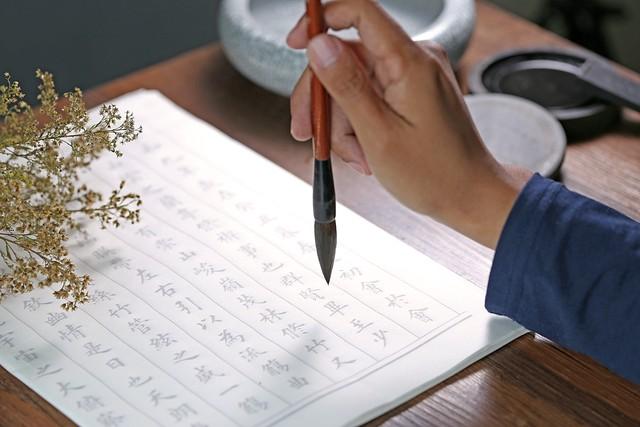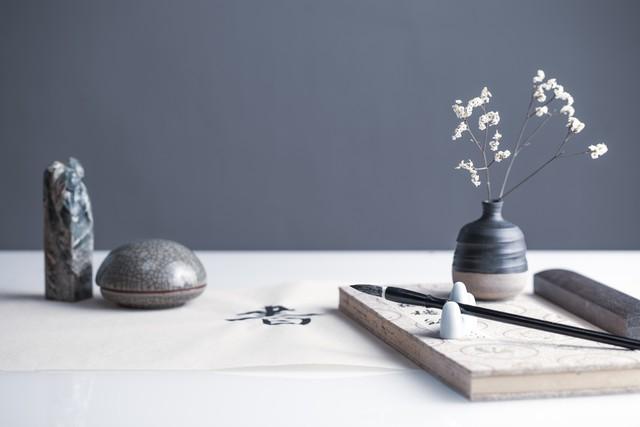A word on calligraphy , presumably the first thing you think of is Chinese characters. In fact, calligraphy is not only a unique art under Chinese culture, but there are many schools of calligraphy in foreign countries, such as Japanese calligraphy and Korean calligraphy that you have heard of. There are also English calligraphy and Arabic calligraphy that you rarely see. In this article, we will discuss the differences between Chinese and foreign calligraphy from various aspects such as artistic style and historical origin.

The origin of Chinese calligraphy is very ancient. It can be traced back to the Neolithic Age six thousand years ago. The ancients invented pictographs for recording. People Burning these characters on random things became the earliest writing method. Oracle bone inscriptions, bronze inscriptions, and official script are all important milestones in Chinese calligraphy. Western calligraphy originated in ancient Greece and ancient Rome, and then experienced unprecedented prosperity through the baptism of the Middle Ages and the Renaissance, and finally formed the current English calligraphy.

In ancient China, calligraphy has always been considered a noble literary art. People pursue the artistic conception and charm of calligraphy. Currently, Chinese characters have four basic fonts , Xing, cursive, official, seal, each font has its own unique features, the running script is flowing, the brushwork is magnificent and smooth, the cursive script is unrestrained and full of freedom, the official script is upright and simple, and the seal script is three-pointed, full of power.

The development of Chinese calligraphy is deeply influenced by history and culture. For example, famous calligraphers such as Su Shi, Ouyang Xun, and Huang Tingjian appeared in the Song Dynasty. After the Ming Dynasty, calligraphy gradually tended to be individualized. Instead of sticking to tradition, innovative calligraphers such as Tang Bohu and Wen Zhengming appeared.
No matter what font or painting, they all have one thing in common, that is, to emphasize the expression of artistic conception, every stroke contains The emotion of the writer allows everyone to feel what the author wants to express through a painting.
Foreign calligraphy styles are also full of differences due to different cultures and regions, such as the Gothic style popular in the Middle Ages in Europe, and the Italian style in the Renaissance These fonts have their own characteristics, but they do not contain artistic conception like Chinese calligraphy, but emphasize the visual effect of English calligraphy through font design and typesetting. This is because the users of Western calligraphy are mainly churches and monasteries, which need to write clearly and standardizedly.

Calligraphy is also very important in the cultural circle of Chinese characters. The cultural circle of Chinese characters refers to some countries influenced by Chinese culture, such as Vietnam, Japan, South Korea Most of their languages are derived from Chinese characters, and calligraphy has naturally become an art form in these countries.
Wang Xizhi can be said to be the most famous calligrapher in our country. In the family of calligraphers, his uncles and cousins are all famous calligraphers. Influenced by him since childhood, Wang Xizhi also loves calligraphy very much. He started to practice calligraphy at the age of 7. When practicing calligraphy in the pool, he dyed the water in the pool black. Later, Wang Xizhi wrote on the wooden board and handed it to the carpenter for carving. It is thick, but Wang Xizhi's handwriting could not be carved away. It turned out that Wang Xizhi's calligraphy skills were so strong that the ink was soaked into the wood, and the allusion of three points into the wood came from this.

During the Tang Dynasty, Emperor Taizong of Tang ordered the collection of Wang Xizhi's works. Wang Xizhi's popularity became famous all over the country, and even neighboring countries learned of Wang Xizhi's exquisite calligraphy , so the Japanese envoys sent to the Tang Dynasty brought Wang Xizhi's calligraphy back to China. Many Japanese who studied calligraphy called Wang Xizhi the sage of calligraphy. Now Japan also collects many Wang Xizhi's handwriting. Come to our country to exchange calligraphy.
Japanese calligraphy is similar to Chinese calligraphy. It is also written with a brush. The main fonts are divided into four types: seal script, regular script, cursive script, and running script. However, with the passage of time, Japan has gradually formed its own calligraphy style. They pursue delicate and soft brushstrokes, revealing an elegant and restrained aesthetic feeling, which is related to Japanese culture and emphasizes inner peace.

Although Korea had its own language system in ancient times, it has always been written in Chinese characters. Especially in the Tang Dynasty, the works of several calligraphy masters such as Wang Xizhi and Ouyang Xun were popular in Korea. During this period, a group of calligraphers influenced by Chinese calligraphy appeared in Korea, such as Cui Zhiyuan, the originator of Korean Han literature.
The development of Korean calligraphy and Japanese calligraphy is similar, but the shape of the font is more round and concise, focusing on expressing the author's spiritual expression.
After Wang Xi, many calligraphers emerged, such as Wang Xizhi’s seventh Chan Master Sun Zhiyong. He practiced calligraphy in temples for 30 years. Practicing handwriting is hardworking, and he will use bad brushes every once in a while, and the bad brushes are piled up in five baskets, so he buried these bad brushes in the soil and named them "Tuibi Tomb" to encourage young people to practice calligraphy . For a time Zen Master Zhiyong was famous far and wide, and many people came to him to ask for a calligraphy work, but there were too many people, and the threshold of the temple was trampled, and the temple had to protect the threshold with iron sheets. "Iron Threshold" is a well-known story.

There are many stories about calligraphy like this in ancient my country, in order to encourage young people to work hard to practice calligraphy, because calligraphy is accumulated over many years. Throughout the history of our country, calligraphers did not rely solely on talent, but on hard work. For example, the above-mentioned Wang Xizhi practiced calligraphy and stained the pool black, or Zen Master Zhiyong practiced calligraphy and used a broken brush. They all teach the world to work hard.
Cultural history has a great influence on calligraphy, allowing the calligraphy of various countries to develop a unique style. Chinese calligraphy has a great influence all over the world Calligraphers will learn from the excellent works of the ancients, and add their own ideas on this basis, and boldly try new styles, such as the old Mr. Qi Baishi who appeared in modern my country. When you mention him, the first thing you think of is probably His paintings, in fact, the old man's calligraphy is also very characteristic, integrating traditional calligraphy and painting into a school of its own.

Calligraphy, as a treasure of our country’s traditional culture, has always attracted people from all over the world to understand Chinese culture, especially neighboring countries, have been affected and developed They all pay attention to the artistic conception, aura, and cultural connotation of calligraphy, and pour into the author's emotions when creating, full of artistic charm. These calligraphy all show the culture of their respective regions, and the mutual reference and exchange of calligraphy between countries, It can not only improve the richness of human culture, but also provide people with a wider aesthetic field.

Articles are uploaded by users and are for non-commercial browsing only. Posted by: Lomu, please indicate the source: https://www.daogebangong.com/en/articles/detail/English%20also%20has%20calligraphy%20What%20is%20the%20difference%20between%20Chinese%20calligraphy%20and%20foreign%20calligraphy.html

 支付宝扫一扫
支付宝扫一扫 
评论列表(196条)
测试